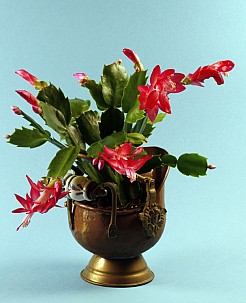10 Facts About Christmas Cacti
 If you’re lucky, you could receive a Christmas cactus as a gift this holiday season. This common house plant blooms during the Christmas season, but its long green arms are attractive throughout the year. With cultivars in a rainbow of colors, it is a plant worthy of appreciation. These 10 facts about Christmas cacti will help you to care for your plant if you're given one this holiday season.
If you’re lucky, you could receive a Christmas cactus as a gift this holiday season. This common house plant blooms during the Christmas season, but its long green arms are attractive throughout the year. With cultivars in a rainbow of colors, it is a plant worthy of appreciation. These 10 facts about Christmas cacti will help you to care for your plant if you're given one this holiday season.
1. It’s called a “cactus”, but thrives in cool temperatures. Christmas cacti need to be kept away from heat sources. Purdue University Extension Service, states that a Christmas cactus will blossom longer when exposed to only cool temperatures. For best results, put your Christmas cactus in a cool place -- away from heaters and fireplaces -- without frequent drafts. Big changes in temperature can cause the cactus blossoms to drop before they open. Optimal temperature for Christmas cacti is 68 degrees F.
2. Christmas cacti need light to bloom. According to Purdue University Extension, keeping your Christmas cactus plants in a sunny location indoors is the key to prolonged blooms. However, if you move them outside during the summer, you’ll have the most success with a partially shaded location, as too much direct light can burn the leaves.
3. The Christmas cactus is native to Brazil. These epiphytes (a plant that grows on top of another plant non-parasitically) are at home in the Brazilian rain forest, among tree branches, discloses Clemson University Cooperative Extension. Since they are tropical plants, they thrive in humid conditions.
4. Christmas cacti need their beauty sleep. The horticulture experts at the Cheyenne Botanic Gardens recommend setting your Christmas cactus in a room where you never turn the lights on at night. In order for the flower buds to set, Christmas cacti need 14 hours or more of continuous darkness per day. However, after the flower buds have set, the plants can withstand light at night.
5. Unlike the other Christmas favorite, Poinsettia, Christmas cactus is not toxic to dogs and cats. Poinsettia is famously poisonous to dogs and cats. However, the ASPCA, reassures that if Fido or Fluffy nibbles on a Christmas cactus, she should not experience irritation or vomiting like she would from the sap of the Poinsettia.
6. Christmas cactus can live for 20 to 30 years. Can you imagine passing a living, flowering plant on to your children or grandchildren? The Old Farmer’s Almanac tells us Christmas cacti can live for 20- 30 years when properly cared for. If you provide long nights starting around October 1, you can force the Christmas cactus to bloom year after year. Cool night temperatures also encourage it to bloom.
7. Overwatering will kill Christmas cacti, but they like to be misted on a daily basis. An Oregon State University Extension Service horticulturist recommends watering a Christmas cactus only when the soil is dry to the touch. Instead, gardening expert and radio host Walter Reeves, the Georgia Gardener, suggests misting the leaves of the Christmas cactus daily, to maintain the desired level of humidity around the plant.
8. 5 diseases commonly infect Christmas cactus. Penn State University Extension experts provide a handy fact sheet outlining the plant diseases that most often affect Christmas cacti. Their list includes basal stem rot, botrytis blight, impatiens necrotic spot virus, phytophthora root rot, and pythium root rot.
9. Fungus gnats, flower thrips, and root mealybugs are the pests that most often infest Christmas cacti. Avoid overwatering, the biggest culprit in attracting pests to Christmas cacti. Preventive care, such as discarding infested plants, is another recommended tactic. Pesticides are available for commercial growers, though home gardeners may not be able to get their hands on them.
10. By the way, that Christmas cactus you are buying is probably not actually a Christmas cactus. Surprise! According to U-Mass Extension Service, “Most commercial cultivars of holiday cactus are actually Schlumbergera truncata, commonly known as Thanksgiving cactus or Zygocactus. True Christmas cactus is an interspecific hybrid of Schlumbergera truncata and Schlumbergera russelliana that originated about 150 years ago in England. It's a common houseplant but not often grown commercially.”
For expert advice on plant care and selection, consult a qualified landscaper.
Updated December 27, 2018.
Looking for a Pro? Call us (866) 441-6648

Landscaping Average Costs
Landscapers Experiences

The Right Landscaper Can Change A Yard From Terrible To Terrific

Yard Cleanup By A Local Landscaper Who Cares About Customers



